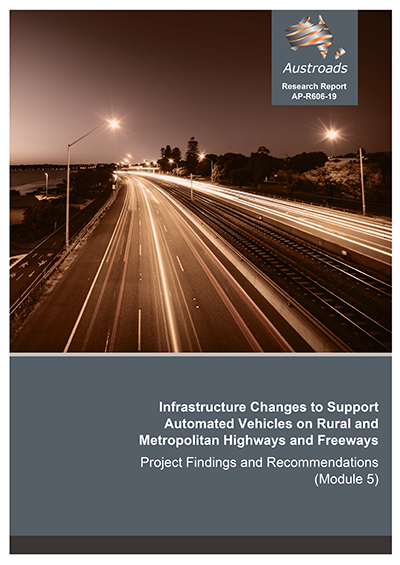Connected and Automated Vehicles

- Publication no: AP-R606-19
- ISBN: 978-1-925854-43-5
- Published: 8 October 2019
- PDF (free) Download
The purpose of this project is to identify the gaps in current physical and digital road infrastructure to support the operation of connected and automated vehicles (CAVs) on key highways and freeways in Australia and New Zealand. By 2025, it can be expected that most new vehicles sold will be equipped with systems that can read traffic lines and signs.
The project consists of five modules, with this module being the final report.
This report outlines the findings of the project, including those from the first four modules, and provides recommendations including prioritising the addition of edge lines to roads and improving contrast between edge lines and adjacent pavements.
These findings have been informed by an extensive review of the literature covering local and international practice, initiatives and lessons learned, complemented by engagement with local and international industry stakeholders (see Module 1), and the results of an extensive field audit (see Module 2).
- Executive Summary
- 1. Introduction
- 1.1 Project structure and relationship to Austroads CAV Program
- 1.2 Roads in scope for this project
- 1.2.1 Coverage of the field audit
- 1.3 This project advances understanding of CAV infrastructure requirements
- 1.4 Better roads or smarter vehicles?
- 2. Exploring how CAVs Interact with Highways
- 2.1 Understanding CAVs as road users – a heterogeneous group
- 2.1.1 Using the SAE levels of automation to explore variance differences in vehicle capabilities
- 2.1.2 How different SAE levels of vehicle respond to uncertainty
- 2.1.3 Exploring different development pathways towards more highly automated driving
- 2.2 CAVs sense and plan before they act
- 2.2.1 CAVs use many different sensors
- 2.2.2 CAVs may use maps in their perception model
- 2.2.3 In more highly automated vehicles, sensor and map data may be integrated into one perception model
- 2.3 Temporary and changed conditions are a challenge
- 2.1 Understanding CAVs as road users – a heterogeneous group
- 3. Infrastructure Requirements for CAVs
- 3.1 Types of infrastructure required to support CAVs
- 3.2 Adopting quality thresholds for infrastructure
- 3.3 This report covers quality, but design also matters
- 3.4 What the automotive industry told us
- 3.5 Requirements for longitudinal line marking
- 3.5.1 Line quality
- 3.5.2 Availability of longitudinal line marking
- 3.5.3 Importance of designs: line patterns
- 3.6 Requirements for road signs
- 3.7 Requirements for maps used by vehicles
- 3.7.1 Requirements for maps to support active safety systems
- 3.7.2 Requirements for maps to support automated driving
- 3.8 Requirements for mobile data coverage
- 3.9 The role of certification or rating systems
- 4. What Changes May be Needed to Asset Standards?
- 4.1 Gap assessment of longitudinal line marking standards
- 4.1.1 Line widths
- 4.1.2 Retro-reflectivity
- 4.1.3 Contrast ratio
- 4.2 Gap assessment of road sign standards
- 4.2.1 Requirements for sign quality at time of installation
- 4.2.2 Requirement to maintain sign quality
- 4.3 Improving infrastructure for CAVs may also benefit human drivers
- 4.4 Improve infrastructure or rely on smarter CAVs?
- 4.5 Estimating costs for infrastructure changes
- 4.1 Gap assessment of longitudinal line marking standards
- 5. How Ready are Australian and NZ Roads?
- 5.1 Where was the field audit conducted?
- 5.2 How did the field audit arrive at its results?
- 5.2.1 Machine vision system post-processing
- 5.2.2 Real-time processing
- 5.3 Audit findings for longitudinal line marking
- 5.3.1 Presence of edge lines and operability of lane departure warning
- 5.4 Audit findings for speed limit signs
- 5.5 Audit findings for mapping
- 5.6 Audit findings for mobile data coverage
- 5.7 Audit findings for temporary conditions
- 5.8 Some visual examples from the audit
- 5.8.1 Good conditions for machine vision systems
- 5.8.2 Audio-tactile edge lines
- 5.8.3 Wide centre line treatments
- 5.8.4 Roads without edge lines
- 5.8.5 Temporary conditions – roadworks
- 5.8.6 Difficult light conditions
- 5.9 Summary of audit findings and lessons learned
- 6. Opportunities from New Data Sources for Asset Management
- 6.1 Increased sensing and analysis capabilities
- 6.2 Several different business models apply
- 6.3 Strengths and weaknesses of different methods
- 6.4 The state of practice is to use specialised survey vehicles
- 6.5 What applications may alternative methods be suited to?
- 6.6 International use of fleet-sourced and crowd-sourced methods
- 6.7 New opportunities for data for asset management – a summary
- 7. Findings and Recommendations
- 7.1 There is a reasonable but not universal level of readiness for active safety systems on freeways and highways in Australia and NZ
- 7.2 It is more challenging to achieve readiness for automated driving and fewer roads are fully suitable for this
- 7.3 Some action can be taken now to improve readiness, but much learning still lies ahead
- 7.4 Austroads should initiate development of a Concept of Operations for automated driving on rural highways
- 7.5 Austroads should work with others to undertake a rural smart highway pilot
- 7.6 Continue to work towards readiness ratings for roads
- 7.7 Use supplements to update technical standards before updating Austroads’ Guide to Traffic Management and Guide to Road Design
- 7.8 Invest in edge lines as a no regrets improvement to infrastructure
- 7.9 Explore opportunities to use new data sources for asset management
- References
